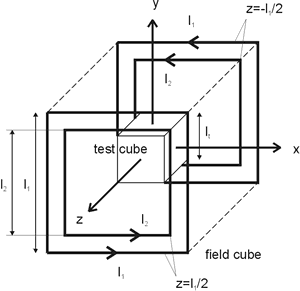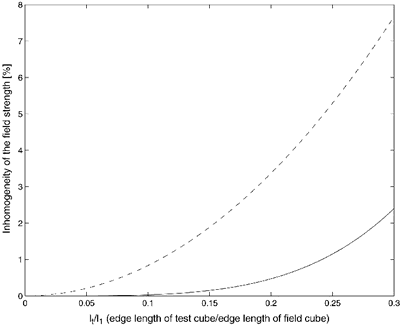
Improving the homogeneity of the magnetic field in the magnetic search coil technique
J. Ditterich
Center for Sensorimotor Research, Department of Neurology, Ludwig-Maximilians University, Munich, Germany
The magnetic search coil technique is the state of the art method for accurate measurements of eye movements. However, the data analysis relies on the assumption that the magnetic fields do not change during the measurement. This would only be the case if the magnetic field were ideally homogeneous or if the measured movements contained no translatory component. Especially when measuring eye movements with the head free, the translatory components are not negligible. Thus, any inhomogeneity in the magnetic field leads to measuring errors. Since the inhomogeneity of the magnetic field depends on the edge length of the field cube, the field cube should be as large as possible. The experimental setup, however, often imposes limitations on its size.

Figure 1. Geometry of the configuration (l1 = edge length of the field cube, l2 = edge length of the supplementary field coils, lt = edge length of the test cube, I1 = current strength in the main field coils, I2 = current strength in the supplementary field coils).
The addition of a second pair of field coils arranged in the same planes as the main ones and centered around the same axis, but with shorter edges and reversed current direction can improve the homogeneity of the magnetic field.
This reduces the field strength without changing the current strength in the main field coils. However, the procedure yields a homogeneity of the magnetic field comparable to that of a standard field cube with almost threefold edge length (obtained by optimizing the homogeneity in a test cube located at the center of the configuration which has a 0.2-fold edge length compared to the field cube). Figure 1 illustrates the geometry. In Figure 2 the inhomogeneity of the magnetic field strength in the standard configuration is compared to that after adding a supplementary pair of field coils.

Figure 2. The inhomogeneity of the magnetic field strength in the standard configuration (dashed line) is compared with that after adding a supplementary pair of field coils with l2/l1 (edge length ratio) = 0.75 and I2/I1 (current ratio) = -0.57 (solid line). The field strength at the center of the configuration is reduced by 49% compared to a standard configuration with identical current strength in the main field coils. The inhomogeneity of the field strength is defined as the maximum deviation of the field strength in a test cube (with given edge length lt located at the center of the configuration) from the field strength at the center and given in %.
Paper presented at Measuring Behavior 2000, 3rd International Conference on Methods and Techniques in Behavioral Research, 15-18 August 2000, Nijmegen, The Netherlands